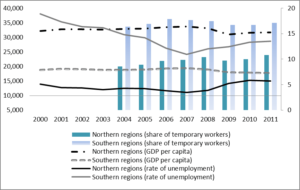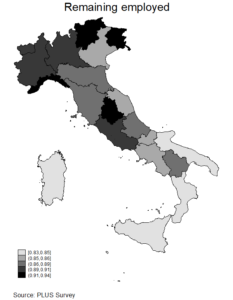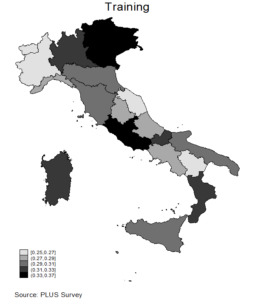Simona Iammarino is Professor of Economic Geography at the Department of Geography & Environment of the London School of Economics and Political Science (UK). Simona’s main research interests lie in the following areas: Multinational corporations, location and innovation strategies, and local economic development; Geography of innovation and technological change; Regional systems of innovation; Regional and local economic development and policy. She has published more than 50 articles in major peer-reviewed journals, two co-authored books, around 30 book chapters, and numerous working papers, policy reports and other publications. She was co-editor of Regional Studies (2008-2013), and she is currently member of the Regional Studies Association (RSA) Publication Committee and of the RSA Research Committee.
By many measures, territorial differences within Europe have grown since the global economic and financial crisis of 2008. Such uneven impacts of the crisis are not unique to any particular country, and have led to calls for more geography-based perspectives on the consequences of economic shocks on labour market outcomes. Here, we consider territorial differences in the impact of a specific measure of skill upgrading – training given to people who are already employed – in securing continued employment in the context of the recent economic downturn across Italian regions. By training, we mean relatively short-term instruction in some well-defined set of employment- related skills.
The provision of training is a matter of growing public and policy concern for two main reasons. One is that the factors that shift deRSAmand – changes in consumer taste, in production technology, in the spatial organization of the division of labour, etc. – have accelerated; a serious downturn such as the crisis of 2008 adds a further immediate demand shock and can accelerate the ongoing structural changes. The second factor is that private sector may lack sufficient incentive to pay for training; for the individual worker, itRSA is an undiversified and risky investment; for the employer, motivation to invest in human capital has weakened during the last decades and, at the same time, public resources for education and training have diminished. Together, these factors both accentuate the need for training, and threaten to undermine the supply.
Changes in demand of and supply for training may be territorially uneven both in their incidence and in their impact on employability. Although research does suggest a number of possible relationships between regional development and training, the effectiveness of training in contrasting higher job losses during economic crises at the sub-national scale has not yet been addressed.
According to previous studies, training generally improves the likelihood of continued employment, reducing job-loss rates. Schooling and training are complementary in their contributions to remaining employed and the effects of both education and training on employment vary with the unemployment rate. When high unemployment puts workers with different skill levels in competition for the same jobs, the more highly educated or better trained are favoured in retaining employment.
We look at Italy, characterized by profound geographical differences – among others, the types of industrial specialization, the quality of education and human capital, and the labour market performance, recently exacerbated by internal migration of highly educated labour force from the Southern to the Central and Northern regions. The Italian economy offers an interesting context for studying the regional impact of training on staying employed. We focus in particular on how the effects of training differ between the South and the North of the country, and across workers with different levels of education, in the period 2008-2011.
With respect to human capital, the South, or Mezzogiorno, is comparable to the North in terms of levels of formal educational qualifications, but it scores lower in terms of internationally standardized measures of literacy and numeracy (e.g. Pisa scores). Following the 2001 constitutional reform, the Italian vocational education and training system was modified in the direction of attributing more responsibility at the regional level, with the idea that training policies should be modelled to reflect the specific territorial specialization. This process of decentralisation has been strengthened further by the shift of the European cohesion policy towards place-based and smart-specialization approaches – the bulk of resources for training deriving from the Structural Funds. As a result, the regions have gained major responsibility in the area of vocational training and its integration with the educational system. Italy has thus experienced an increase in the variety of local training instruments going from incentives to employability to professional re-training.
Figure 1 shows that the GDP gap between the two Italian macro-areas is considerable, and fairly steady over the 2000s. The unemployment rate in the South is always much higher, but substantial convergence (and overall decline in the rate) occurs between 2000 and 2007, while a steady difference in the rates (in the context of rising unemployment overall) happens between 2008 and 2011. The share of temporary workers is also considerably higher in the Mezzogiorno regions, though the difference has slightly reduced since the outset of the crisis.

Figure 1. – GDP at market prices per inhabitant, left axis (2000-2011); Unemployment rate, right axis (2000-2011); share of temporary workers, right axis (2004-2011). Source: ISTAT.
Using data on individuals coming from the PLUS Survey[1], Presented below are two maps. Map 1 compares regional rates for remaining employed in 2011 if employed in 2008 (the rate tends to be higher in the North). Map 2 shows rates of training while employed by region over the period 2008-2010 – this is the share of those employed who reported participation in training in the PLUS surveys of 2008, 2010, or both. Here there is no clear South-North pattern; both in the South and in the North we see a mix of regions with low, middling and high levels of training participation.
Map 1 – Remaining employed over the period 2008-2011, regional averages

Map 2 – Participation in training while employed over the period 2008-2010, regional averages.

Consistent with previous findings, we find that workers with more education are more likely to receive training. Workers in the North are also more likely to receive training and, not surprisingly, training increases the likelihood of remaining employed. Crucially, the impact of training on continued employment differs notably across sub-national geography. Our striking finding is that training has a clear positive and significant effect on the probability of a worker’s remaining employed through the financial crisis in the Italian South, but it has no impact in the North. This applies at all levels of formal educational attainment.
These differences across Italy’s twenty regions are in initial unemployment, change in unemployment, or GDP per capita, all of which are taken into account in the analysis. It is most pronounced in the private sector, but a South-North difference is evident in the public sector as well. It remains strong when we use instrumental variable techniques to correct for endogeneity; and it remains so when we add further region-level controls for industry structure, quality of education, and social capital.
To understand any of these differences we will need to know more about the local demand side of the labour market. Literature on industry structure and inter-firm relations tells us that Southern Italian firms internalise more functions, have more limited external networks, and are less likely to be located in specialised clusters or industrial districts. All these features are not considered a good recipe for innovation or for job creation. On the other hand, the same characteristics also describe the Italian Mezzogiorno mostly as an environment in which inter-firm job mobility is likely to be lower, as it is the threat of labour poaching. This may be more conducive to training by employers, or to a stronger association between such training and remaining with that same employer. It may also be that, under these circumstances, provision of training is more firm-specific in the Southern regions, making the costs of dismissal relatively higher for firms there located.
This does suggest, similar to Shuttleworth et al. (2005) concluded in the case of the UK, the need for a geographical approach to labour market policy. Where demand is low and inter-firm mobility is slight, it is difficult to maintain a pool of skilled labour. Skills obtained outside the firm, notably in universities, tend to leave the area, while those obtained inside the firm tend to stay put in that same firm. Under such conditions, an effective skills policy must either go together with the easing of inter-firm barriers, emergence of specialised agglomerations, and integration in value chain networks, or with working in collaboration with employers to support their internal skills needs and technological upgrading. There is some hope that the latter may aid the former: Feldman (2014), among others, has shown how many large specialized agglomerations have grown from single successful firms that provided good training and inadvertently fostered the creation of competitors, staffed by their own ex-employees. Yet, hoping to see such an outcome flowing from one or more large employers in the South of Italy may be vain. The business culture and other informal institutions of the Mezzogiorno are known to be unfriendly to it, and some of the competing regions benefit not simply from Marshallian pools of skilled labour, but from inter-firm cooperation in training which actively feeds these pools.
This, however, is speculative. Before we can draw definite policy conclusions from our findings, we must understand what drives them, and specifically how they are connected to sub-national variation in industry structure, informal institutions and the effectiveness of formal institutions.
[1] Survey on Labour Participation and Unemployment (PLUS) carried out by the Institute for the Development of Vocational Training for Workers (ISFOL). In our analysis we use the balanced panel of 2008, 2010 and 2011 waves, including 12,593 individuals in each wave.
References
Feldman, M. (2014) The character of innovative places: entrepreneurial strategy, economic development and prosperity, Small Business Economics, DOI 10.1007/s11187-014-9574-4.
Shuttleworth, I., Tyler, P. and McKinstry, D. (2005) Redundancy, readjustment, and employability: what can we learn from the 2000 Harland &Wolff redundancy?, Environment and Planning A, 37, 1651-1668.
This blog post is based on: Filippetti A., Guy F. and Iammarino S. (2018), Regional disparities in the effect of training on employment, Regional Studies, 53:2, 217-230 https://www.tandfonline.com/doi/full/10.1080/00343404.2018.1455177
Are you currently involved with regional research, policy, and development, and want to elaborate your ideas in a different medium? The Regional Studies Association is now accepting articles for their online blog. For more information, contact the Blog Editor at RSABlog@regionalstudies.org.